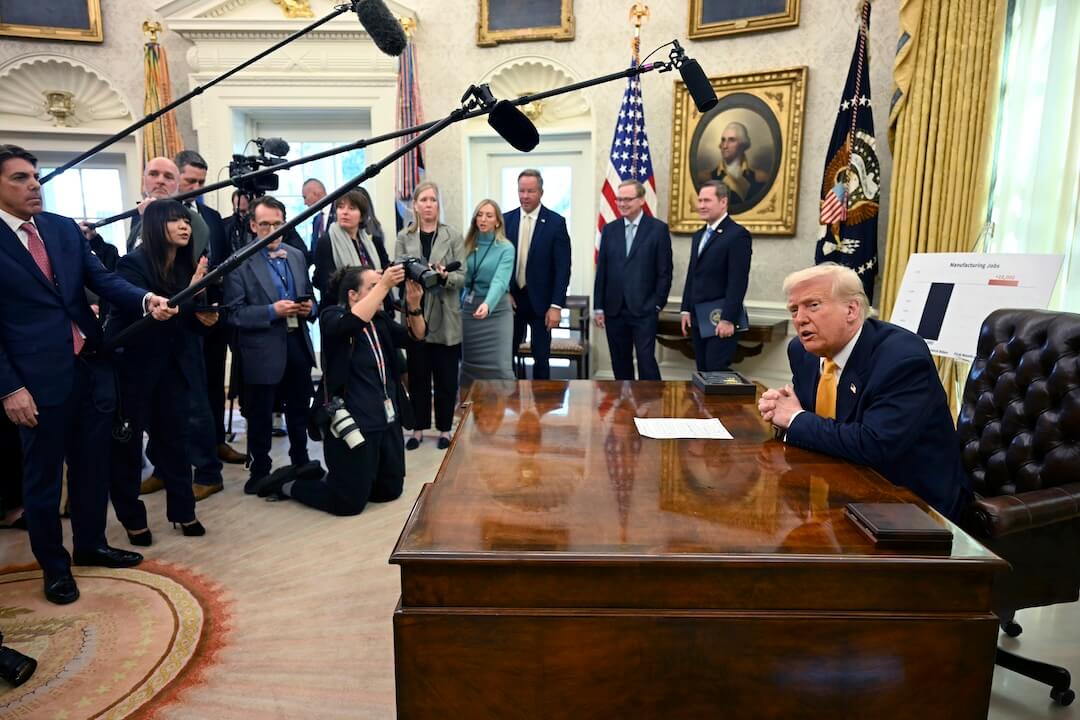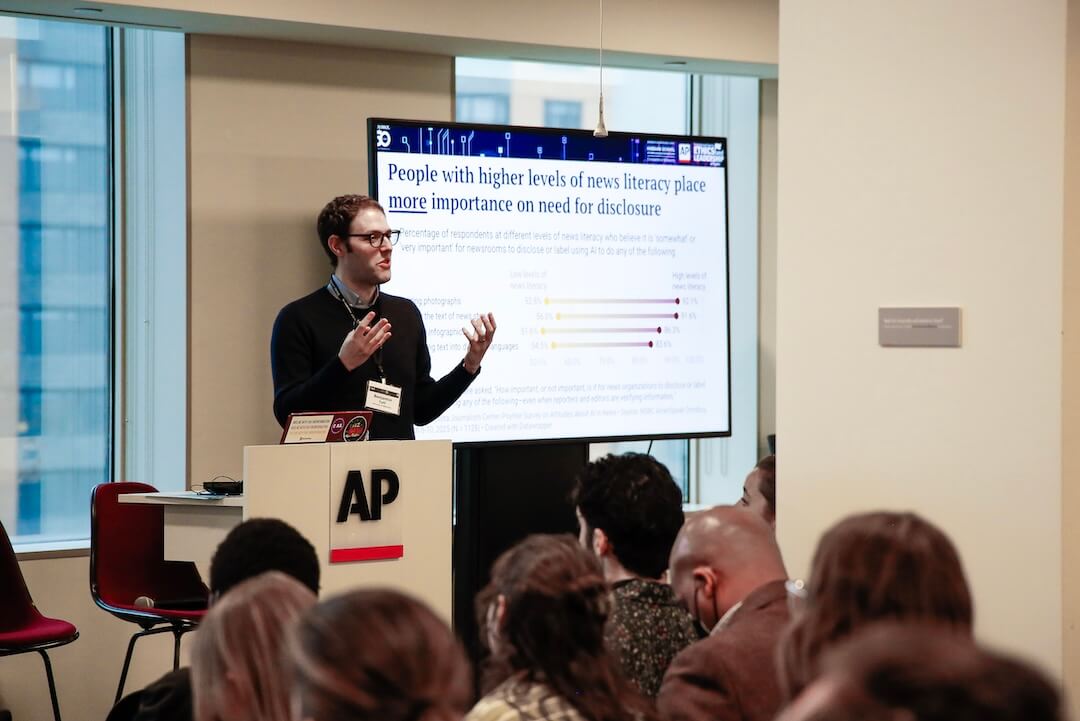
Members of the Newspaper Guild of Greater Philadelphia rally outside the Philadelphia Inquirer and Daily News building in 2006. Union members will vote Wednesday on whether to give leaders the right to call a walkout. (AP Photo/George Widman)
Union members in Philadelphia will vote Wednesday evening on whether to give leaders the right to call a walkout and potentially trigger an American labor relations rarity: a big city newspaper strike.
In fact, you’re far more likely to ever see a lunar eclipse than a newspaper strike. We at least tend to get an eclipse or two every year. Guess when the last big newspaper strike was?
The contract between the Philadelphia Media Network and the Newspaper Guild expired May 23 but is extended to June 27 by mutual agreement. Recent sessions have not seen much progress and, on Wednesday, union members will vote on the strike authorization. That would let leadership call a walkout if there’s no deal by the new deadline.
And, by total coincidence, what could prove a notable if unrelated labor relations happening is playing out in New York: an attempt to unionize workers at Gawker Media, a “hot” online company. If would be the first digital news site to unionize as a result of a vote Wednesday. Its results will be disclosed Thursday.
In Philadelphia there actually are two contracts at play: one that covers employees at the Philadelphia Inquirer and the Daily News who work in editorial, advertising, circulation and finance.
The other pact covers Philly.com employees. The combined union membership covered by both is about 500, according to Bill Ross, executive director of The Newspaper Guild of Greater Philadelphia, Local 38010.
Talks are being overseen by the Federal Mediation and Conciliation Service with the central issues including employee contributions to health care benefits and the ways in which any future layoff might be instituted, including traditional first-in, last-out seniority practices.
But if those are pretty typical issues in union talks these days across all sectors of the economy, it is also fairly typical that management tends to have most the leverage.
That’s been true in the newspaper industry for several decades. It is no coincidence that the last major big city strikes were in Detroit, spanned several years and ended with a settlement in 2000.
Before then two of the bigger walkouts, which I actually covered: production workers in 1985 at the Chicago Tribune and production and editorial workers in 1990 at the then Tribune Co.-owned New York Daily News.
At the Daily News, where I am a contributing editor, the company not only lost the strike but also ultimately paid British newspaper baron Robert Maxwell $60 million to take it off its hands in 1991 (Maxwell died mysteriously off his yacht in the Mediterranean that same year.). The paper was then bought out of bankruptcy in 1993 by its current owner, Mort Zuckerman, who now reportedly has it on the block.
The Newspaper Guild has always offered important protections for reporters. Henry Weinstein, a former Los Angeles Times labor writer and now a professor at the University of California’s Irvine School of Law, on Sunday in an email recalled how he and Larry Kramer (now publisher of USA Today) would have probably been fired as young reporters at the San Francisco Examiner in the late 1970s were it not for the Guild.
They rankled management by helping to start a defense fund for two other reporters hit with a libel suit filed by law enforcement officers. The officers won $4.56 million verdict against the paper, reporter Raul Ramirez and freelancer reporter Lowell Bergman over a story that claimed a murder conviction resulted from perjured and misleading testimony.
The appeal by the reporter defendants dragged on for many years before the California Supreme Court threw out the lower court decision, with that ruling later affirmed by the U.S. Supreme Court. Indeed, so much time had passed, Kramer recalled to me Sunday, that he’d left the paper but by the end of the odyssey returned as executive editor to help guide and enjoy the legal victory.
For sure, Guild support for reporters in individual matters remains. But the balance of power between labor and management over contracts changed dramatically within the industry in recent decades.
Much of that was the simple and convulsive function of new technology as entire groups of workers, such as typesetters, were dramatically reduced or even eliminated by computerization.
Overall, union membership in the U.S. was down last year to 11.1 percent of the total workforce, according to the Bureau of Labor Statistics at the Department of Labor. The peak was 28.3 percent in 1954.
In the newspaper business the coming of the Internet only accelerates the peril for the army of workers—from pressmen to delivery drivers—whose predecessors made good wages when print editions were the source of revenue for employers. The decline in print has brought declining revenues and layoffs throughout a paper’s ranks, including the newsroom.
“1995 was the best year ever for newspaper industry in terms of revenue. The Internet emerged in mid-’90s and you know the rest,” says Alan Mutter, an industry analyst and a former editor at several papers.
“The best unions can do today is to try to save jobs and benefits. Usually, they lose because publishers have all the leverage.”
A rather unsparing critique came my way Sunday from William Serrin, former longtime labor writer for The New York Times and a retired New York University Journalism professor:
“There are, in a large sense, no labor relations in the newspaper industry,” he said. “The industry is led by people with no knowledge of journalism history or how to create a new kind of journalism in a post newsprint era.”
“The unions are worse. Union people have no idea about what is going on in the newspaper or magazine business or how to face the future.”
Ronald Seeber, a Cornell University professor of industrial relations said, “This is kind of a hopeless situation on both sides for this part of the economy… When was last time you bought a paper on a newsstand?”
“Maybe you get a Sunday paper delivered to your home. In Syracuse [N.Y.] we had two dailies. Now it’s just print on Sundays and Syracuse.com.”
The obvious shift to online consumption brings with it a business challenge with huge ramifications for a labor negotiation, as readily conceded by Bill Ross, executive director The Newspaper Guild of Greater Philadelphia, Local 38010.
“They have given away their product for free,” he says, specifically referring to Philadelphia but with obvious relevance to the entire industry. “How do you now start charging readers when you have given it away for free? It’s very difficult.”
“Our employer clearly has not figured it out and it is a problem for us.”
Seeber sees the bind the two sides are in as predictable and a window on issues prevalent throughout the economy.
“There are health care costs, which have been so underfunded, and people haven’t had a raise in a long time, basically working for basically the same scale,” he said. “And the guild is trying to maintain seniority, which one can understand. But it’s still not clear how really serious the publisher here is in getting rid of such a bedrock union principle.”
The end result: “Workers are unhappy, but there’s not the market to support big economic change.”
Ultimately, the deck could be seen as stack, with the Guild up against a billionaire businessman-philanthropist owner, H.F. “Gerry” Lenfest. But its goal is sincere and itself predictable.
“We just want a fair contract,” says Ross. “Our members deserve one from new billionaire owner.”






